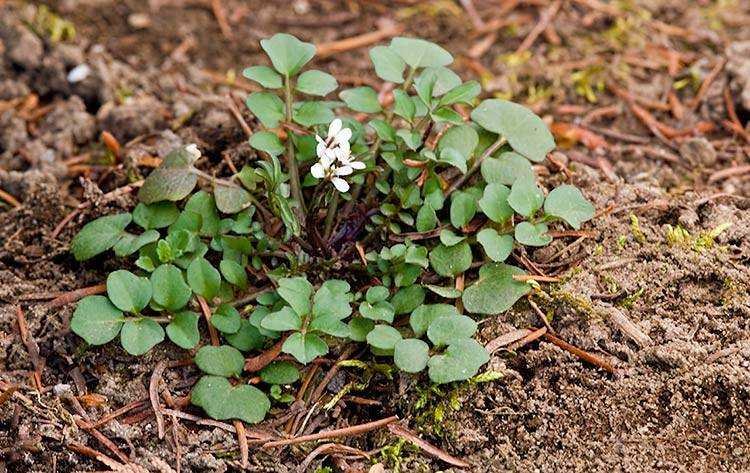Beautiful Plants For Your Interior
Hairy Bittercress

Quick Weed Facts:
Shape: Small, green and rounded leaves growing in opposite pairs along the leaf stem
Colour: Flower White (All Year)
Family: Brassicaceae Genus: Cardamine
Main Species: Hairy Bittercress (Cardamine hirsuta)
Other Names: Hairy Bittercress, Lambs Cress, Land Cress, Spring Cress, Hoary Bittercress, Shot Weed, Flick Weed
Most Active Growing: Spring/Summer/Autumn/Winter
Weed Type: Annual/Biannual
Relatively easy to identify the plant Hairy Bittercress (Cardamine hirsuta) is native to the United Kingdom and grows only rarely to around 30cm (1ft) but often much smaller.
The name is a little misleading, as hairy bittercress only has ‘slightly hairy’ stems emerging from a central rosette, with dark green leaves about 0.5cm across. The plant grows small ‘white flowers’ that develop into long, narrow seed pods.
Cardamine hirsuta is one of two ‘bittercress’ species found in the UK, however, it should not be confused with the other common bittercress, Wavy Bittercress (Cardamine flexuosa) which is not part of this post, but we will touch on it generally below.
Generally, throughout the British Isles, the Hairy Bittercress (Cardamine hirsuta) is found on bare or uncultivated ground, gravel paths, lawns, and walls. It is found particularly in nurseries and garden centres, as it often grows on ‘container’ surfaces and maybe ‘unintentionally’ introduced to gardens in conjunction with container-raised plants.
Wavy Bittercress (Cardamine flexuosa) a biennial or perennial species, is most common in moist and shady spots, such as near streams and found throughout the British Isles, it only occasionally causes problems in gardens though, particularly in moist or poorly drained parts of the garden.
Hairy Bittercress: Easily Identify Hairy Bittercress (Cardamine hirsuta)
Hairy Bittercress Seeds Are The Problem
Although quite an insignificant weed compared to some garden weeds, Hairy Bittercress once discovered in your garden and left unchecked can become a major issue in many a garden. The problem is the ‘explosive’ seed mechanism of the plant.
Hairy bittercress is self-pollinating and once flowered goes on to produce red/brown ‘pea pods’. These pods can be formed possibly all year round if the weather is mild, although generally Hairy Bittercress can be found in flower from March through to August.
Annual weeds like hairy bittercress must be ‘cleared out’ before seed production, to prevent them from spreading. The seeds of this plant can be distributed up to 1m (3ft) away or even further if they are blown by the wind.
With this being said, hairy bittercress sheds its ‘seeds’ from May, occasionally through into the autumn. An average of 20 seedpods per plant are produced, but a larger plant may generate several thousand seeds. It is therefore easy to see how quickly hairy bittercress can become a gardener’s nightmare.
Hairy Bittercress Weed Control
It’s important to prevent hairy bittercress from establishing in the garden, and even more critical to prevent it from flowering and producing seeds. Failure to do this will make eradicating it a longer and more difficult process. It is crucial to identify and eradicate hairy bittercress early to prevent it from taking over the garden.
Natural Control Of Hairy Bittercress
You can easily and quickly control weed seedlings and young plants by ‘hoeing’ them as soon as you see them. It is vital to slice through the weed stems at ground level or just below ground level, eliminating the plant’s top growth from its roots. Sharpening the blade before using the hoe will make it even simpler and quicker.
Use the hoe on a hot and or windy day, as plants will ‘dehydrate’ and die quickly in these conditions. When the plants are more developed, digging them out is a lot more time-consuming and difficult, especially if they are growing with other plants in the garden, so early identification and eradication are best. Flame guns and weeders that operate with electricity can also be effective in certain environments.
Mulching soil with ‘organic matter’ will prevent seeds from germinating and will prevent light from reaching the soil thus staving the plant of the light it needs to thrive. Weed-control membrane (landscape cloth) or thick black polyethene can also be used to cover the ground just as well. Note that mulches though should be at least 5cm (2in) thick, but a 7.5cm (3in) layer works better as you are sure to block out all the light.
Best Herbicide for Hairy Bittercress
Annual weeds such as Cardamine hirsuta may be controlled on bare waste ground or paths using contact weedkillers such as Weedol Gun Fast-Acting or Job Done Garden Ultrafast Weedkiller.
Glyphosate Roundup Fast Action, for example, may be used to control Cardamine flexuosa, provided that the plants are allowed to flower before the herbicide is applied. When handling glyphosate, you avoid contact with the leaves and green parts of all other garden plants, as this or any herbicide, is not selective in its action.

Hairy Bittercress: Plants can be eradicated easily by the use of a ‘garden hoe’ as soon as plants appear
FAQ’s
Is Hairy Bittercress Poisonous To Dogs?
No, Hairy Bittercress is not poisonous to dogs or other animals. However, it can be a choking hazard if ingested in large quantities, so it’s best to keep your pets away from the plant.
Can You Eat All Bittercress?
Both Hairy Bittercress (Cardamine hirsuta) and Wavy Bittercress (Cardamine flexuosa) are great additions to use in a ‘salad’ or as a garnish. Most people however find the ‘flowers’ and ‘stalks’ inedible.
Just make sure you rinse the bittercress well prior to eating if you pick it directly from fields or waste ground.
Bittercress has a cress-like flavour (peppery) and should be eaten raw. You may also use sharp or sweet dressings with it.
When Does Hairy Bittercress Grow?
Hairy Bittercress can grow year-round in mild climates, but it typically grows in the spring and summer months. It prefers moist soil and can often be found in gardens, lawns, and other areas with high moisture content.
Conclusion
Hairy Bittercress (Cardamine hirsuta) is a common weed found throughout the UK and the plant is active throughout most of the year, although spring and summer are the most active of times.
It’s important to identify the weed early to ensure it does not spread through the areas of your garden where it could be very difficult to eradicate by affecting other plants. If caught early like most weeds, it can be controlled and or eradicated by organic and or chemical means as we have mentioned above.
Although a weed, this plant does have some culinary value, if you choose to use it in salads and stews., so it’s not all bad.
So check your garden regularly for signs of this common UK weed to ensure it does not become a bigger problem than it needs to be.
Don’t forget to visit our FAQ page for many more gardening tips, tricks and information on a whole host of subjects for the home and garden.
Return to Garden Weeds
